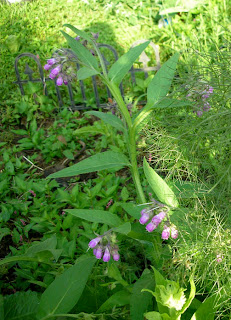By popular demand, the Independence Days Challenge is back! Every Friday from February - September we are challenged to work on our skill set. Anyone can join in!
The categories and my responses:
Plant something: A lot of us were trained to think of planting as done once a year, but if you start seeds, do season extension and succession plant, you’ll get much, much more out of your garden, so I try and plant something every day from February into September.
Plant something:
-started more seeds: foxglove, balloon flower
-transplanted some lettuce seedlings, strawberry plants given to me by a friend
-repotted peppers into larger containers & rearranged plants in green house to shuffle exposure to sunlight
-transplanted some lettuce seedlings, strawberry plants given to me by a friend
-repotted peppers into larger containers & rearranged plants in green house to shuffle exposure to sunlight
Harvest something: Everything counts – from the milk and eggs you get from your animals to the first dandelions from your yard to 50 bushels of tomatoes – it all counts.
Harvest something:
Eggs
Milk
Wild greens: chickweed, nettles, dandelion, chicory
red clover blossoms
sow thistle
red clover blossoms
sow thistle
Preserve something: Again, I find preserving is most productive if I try and do a little every day that there is anything, from the first dried raspberry leaves and jarred rhubarb to the last squashes at the end of the season.
Preserve something:
-Drying red clover blossoms
-tinctured sow thistle
-tinctured sow thistle
Waste not: Reducing food waste, composting everything or feeding it to animals, reducing your use of disposables and creation of garbage, reusing things that would otherwise go to waste, making sure your preserved and stored foods are kept in good shape – all of these count.
Waste Not:
-Fed chickens, dog and cats scraps; composted unfeedable scraps
-free range grazing the sheep and tethering the goats (about 6 weeks earlier than usual, i completely forgot this one...we have an entire round bale of hay left)
Want Not: Adding to your food storage or stash of goods for emergencies, building up resources that will be useful in the long term.
Want Not:
-purchased perennials vegetables for building our perennial garden up (focusing on permaculture again)
-purchased Kristi Shapla's awesome herbal brew book: Brew Your Own Medicine. i'm excited to try making a gluten free beer
-purchased 2 coghlan's sportsman pocket saws for our 72 hour kit and first aid kit
-purchased a camp toaster that works on top of a gas camp stove (to which my daughter said 'did you just buy a toaster to toast bread that you can't even eat?!...' which was met with hysterical laughter on my part...once i caught my breath, i retorted...someday we shall have an oven again and i can make rye bread or gluten free bread)
-purchased assorted band-aids from finger shaped to large wound size. we were lacking in larger sized bandages and find them useful for both humans and animals.
-purchased contact solution
-purchased 2 coghlan's sportsman pocket saws for our 72 hour kit and first aid kit
-purchased a camp toaster that works on top of a gas camp stove (to which my daughter said 'did you just buy a toaster to toast bread that you can't even eat?!...' which was met with hysterical laughter on my part...once i caught my breath, i retorted...someday we shall have an oven again and i can make rye bread or gluten free bread)
-purchased assorted band-aids from finger shaped to large wound size. we were lacking in larger sized bandages and find them useful for both humans and animals.
-purchased contact solution
Eat the Food: Making full and good use of what you have, making sure that you are getting everything you can from your food, trying new recipes and new cooking ideas, eating out of your storage!
Eat the Food:
-eating lots of eggs and milk
-hard boiled eggs, deviled eggs
-made yogurt from our milk
-making butter with cream
-lots of wild greens: chickweed, nettles, cleavers, violets, dandelions, chicory
-dandelion fritters, nettles in stir fry
Build community food systems: What have you done to help other people have better food access or to make your local food system more resilient?
Build Community Food Systems:
-offering milk and eggs to my community
-offering herbal medicines to friends
-taught monthly herbal study group class on Herbs for Kids (treating kids with herbs)
And a new one: Skill up: What did you learn this week that will help you in the future – could be as simple as fixing the faucet or as hard as building a shed, as simple as a new way of keeping records or as complicated as making shoes. Whatever you are learning, you get a merit badge for it – this is important stuff.
Skill Up:
-still studying up on common and uncommon, infectious and non-infectious diseases and what herbal medicines would best be suited for them














